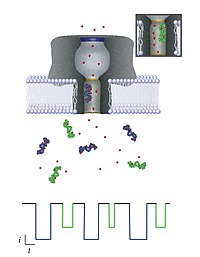
Photo from wikipedia
Solid state nanopores are single-molecular devices governed by nanoscale physics with a broad potential for technological applications. However, the control of translocation speed in these systems is still limited. Ionic… Click to show full abstract
Solid state nanopores are single-molecular devices governed by nanoscale physics with a broad potential for technological applications. However, the control of translocation speed in these systems is still limited. Ionic liquids are molten salts which are commonly used as alternate solvents enabling the regulation of the chemical and physical interactions on solid-liquid interfaces. While their combination can be challenging to the understanding of nanoscopic processes, there has been limited attempts on bringing these two together. While summarizing the state of the art and open questions in these fields, several major advances are presented with a perspective on the next steps in the investigations of ionic-liquid filled nanopores, both from a theoretical and experimental standpoint. By analogy to aqueous solutions, it is argued that ionic liquids and nanopores can be combined to provide new nanofluidic functionalities, as well as to help resolve some of the pertinent problems in understanding transport phenomena in confined ionic liquids and providing better control of the speed of translocating analytes.
Journal Title: Small
Year Published: 2021
Link to full text (if available)
Share on Social Media: Sign Up to like & get
recommendations!